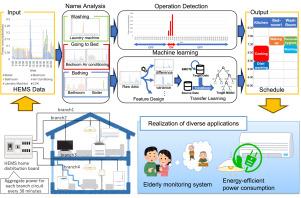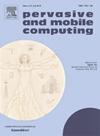Home activity recognition using infrequently-monitored HEMS Data
IF 3.5
3区 计算机科学
Q2 COMPUTER SCIENCE, INFORMATION SYSTEMS
引用次数: 0
Abstract
This paper proposes a method for estimating household activities based only on the cumulative power consumption data obtained from the HEMS home distribution board every 30 min. The proposed method predicts the activity of each 30 min timeslot from the eight activity labels; household-level waking-up, household-level going-to-bed, room-level waking-up, room-level going-to-bed, cooking, laundry, dishwashing, and bathing. For the prediction, we first identify the branch circuit that is strongly correlated with each activity label and detect the turn-on/off of home appliances on the circuit to detect those activities. We also incorporate machine learning for estimating the other activities based on the circuit’s time series of power consumption. Furthermore, to cope with the difference among households, we apply transfer learning to the constructed model. In collaboration with a Japanese home builder, we conducted an experiment on five households using their HEMS data. In parallel, we obtained verifiable activity labels as our ground truth by the installation of specialized sensors in the respective homes. Under a ±30 min tolerance (i.e. allowing a prediction in the immediately preceding or following half-hour slot), our model achieved an average F1 score of 0.689 across all activities. We also confirmed that transfer learning improved the F1 score of each activity recognition and achieved an average improvement of 0.260 in household-level waking-up, household-level going-to-bed, room-level waking-up, room-level going-to-bed, and bathing activities.

使用不经常监测的医疗卫生系统数据进行家庭活动识别
本文提出了一种仅基于HEMS家庭配电板每30分钟获得的累计电力消耗数据来估计家庭活动的方法。该方法从8个活动标签中预测每个30分钟时间段的活动;家庭级别的起床,家庭级别的睡觉,房间级别的起床,房间级别的睡觉,做饭,洗衣,洗碗,洗澡。为了预测,我们首先确定与每个活动标签密切相关的分支电路,并检测电路上家用电器的开关以检测这些活动。我们还结合了机器学习来估计基于电路功耗时间序列的其他活动。此外,为了处理家庭之间的差异,我们将迁移学习应用于所构建的模型。我们与一家日本房屋建筑商合作,对五户家庭进行了实验,使用他们的医疗卫生系统数据。与此同时,我们通过在各自的家庭中安装专门的传感器,获得了可验证的活动标签作为我们的基础事实。在±30分钟的误差范围内(即允许在之前或之后的半小时时段进行预测),我们的模型在所有活动中获得了0.689的平均F1分数。我们还证实,迁移学习提高了各项活动识别的F1得分,在家庭级起床、家庭级上床睡觉、房间级起床、房间级上床睡觉和洗澡活动中平均提高了0.260。
本文章由计算机程序翻译,如有差异,请以英文原文为准。
求助全文
约1分钟内获得全文
求助全文
来源期刊

Pervasive and Mobile Computing
COMPUTER SCIENCE, INFORMATION SYSTEMS-TELECOMMUNICATIONS
CiteScore
7.70
自引率
2.30%
发文量
80
审稿时长
68 days
期刊介绍:
As envisioned by Mark Weiser as early as 1991, pervasive computing systems and services have truly become integral parts of our daily lives. Tremendous developments in a multitude of technologies ranging from personalized and embedded smart devices (e.g., smartphones, sensors, wearables, IoTs, etc.) to ubiquitous connectivity, via a variety of wireless mobile communications and cognitive networking infrastructures, to advanced computing techniques (including edge, fog and cloud) and user-friendly middleware services and platforms have significantly contributed to the unprecedented advances in pervasive and mobile computing. Cutting-edge applications and paradigms have evolved, such as cyber-physical systems and smart environments (e.g., smart city, smart energy, smart transportation, smart healthcare, etc.) that also involve human in the loop through social interactions and participatory and/or mobile crowd sensing, for example. The goal of pervasive computing systems is to improve human experience and quality of life, without explicit awareness of the underlying communications and computing technologies.
The Pervasive and Mobile Computing Journal (PMC) is a high-impact, peer-reviewed technical journal that publishes high-quality scientific articles spanning theory and practice, and covering all aspects of pervasive and mobile computing and systems.
 求助内容:
求助内容: 应助结果提醒方式:
应助结果提醒方式:


